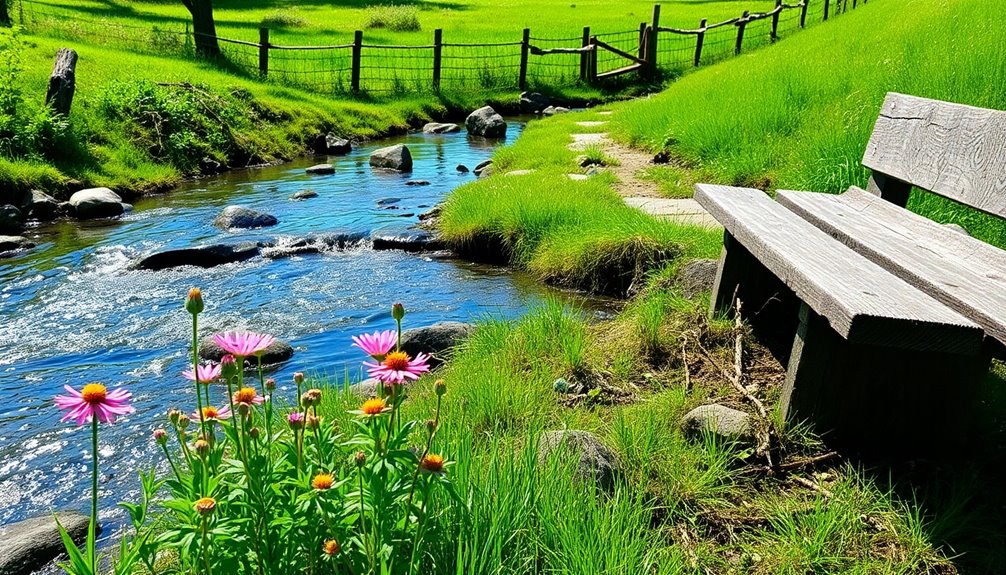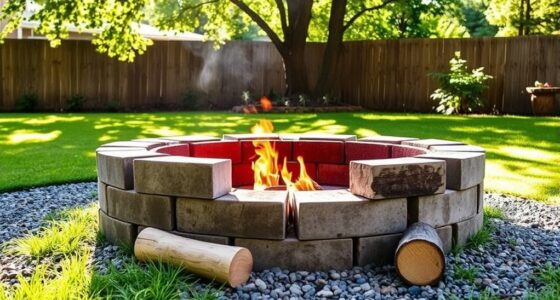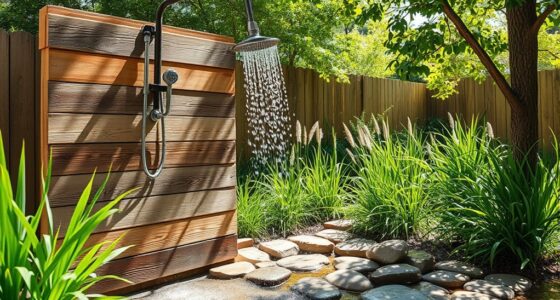Having a creek on your property can greatly enhance its beauty and provide recreational opportunities like fishing and nature walks. However, it also presents safety risks, especially for unsupervised children, so proper precautions are essential. You might face financial implications like higher insurance costs and the potential for flood damage. Wildlife interactions can enrich your experience but may require management to avoid nuisance animals. Additionally, maintaining the creek area can be challenging due to erosion and vegetation restrictions. Exploring these aspects can help you weigh the benefits against the drawbacks effectively.
Key Takeaways
- Aesthetic Appeal: A creek enhances property value and provides a serene environment, promoting relaxation and recreational activities.
- Wildlife Interaction: Properties with creeks offer opportunities for wildlife observation and interaction, enriching the natural experience for residents.
- Flood Risk: Properties near creeks face significant flood risks, leading to higher insurance costs and potential financial liabilities.
- Safety Concerns: Unsupervised children near creeks are at risk of drowning; safety measures like fencing and strict rules are essential.
- Maintenance Challenges: Owners must manage erosion and vegetation, often facing regulatory restrictions on creekside landscaping and upkeep.
Aesthetic Appeal and Tranquility
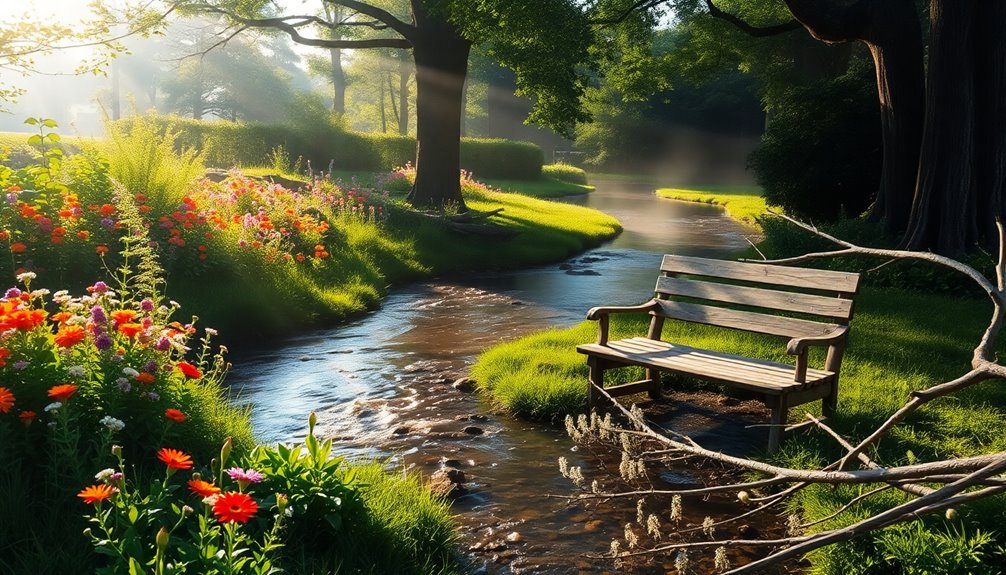
A creek on your property can instantly transform your landscape into a serene oasis. The flowing water enhances the aesthetic appeal of your surroundings, creating picturesque views that draw the eye and calm the mind.
Imagine stepping outside to the soothing sounds of babbling water, promoting tranquility and relaxation after a long day. Homes near creeks typically attract buyers seeking that peaceful atmosphere, often increasing your property's value.
Plus, creeks offer a natural habitat for wildlife, allowing you to enjoy birdwatching and other fauna right in your backyard.
With a creek, you can creatively landscape your outdoor space, turning it into a vibrant retreat that invites you to unwind and connect with nature.
Recreational Opportunities for Families
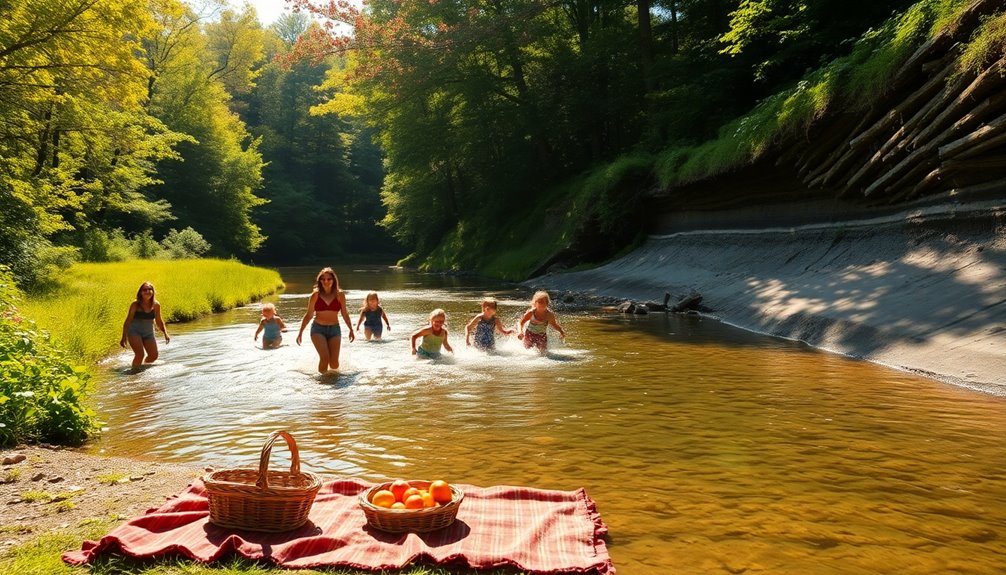
Having a creek on your property opens up a world of fun for your family.
You can explore nature, enjoy water play, and observe local wildlife right in your backyard.
These activities not only entertain but also help create lasting memories together. Incorporating multifunctional furniture near the creek can enhance your outdoor family gatherings and activities.
Nature Exploration Activities
While exploring a creek on your property, you and your family can immerse yourselves in a world of nature-filled adventures that spark curiosity and creativity. The creek serves as a gateway for wildlife observation and hands-on learning about local ecosystems. You can enjoy tranquil picnics or storytelling sessions by the water's edge, making memories that last a lifetime. Additionally, these outdoor experiences can be complemented with health benefits of frozen yogurt, providing a refreshing treat after a day of exploration.
Here's a table of nature exploration activities you can enjoy:
| Activity | Description |
|---|---|
| Wildlife Observation | Spot local birds and insects |
| Fishing | Teach kids fishing techniques |
| Wading | Explore shallow areas safely |
| Building Dams | Encourage creativity with materials |
These activities promote physical activity and deepen your family's connection to nature.
Water-Based Play Fun
Exploring a creek on your property opens up a world of water-based play that's perfect for families. Imagine your kids wading through the cool water, building dams, and letting their imaginations run wild.
This natural play area not only fosters creativity but also encourages physical activity, reducing screen time and promoting overall health. You can enhance family bonding with picnics by the water, fishing trips, or leisurely nature walks along the creek bank.
Seasonal changes add excitement, with opportunities for swimming in the summer and observing wildlife migrations in the fall. Your kids would learn about local ecosystems in a fun, hands-on way, making every visit an adventure that connects them to nature and each other.
Wildlife Observation Opportunities
A creek on your property can serve as a vibrant ecosystem teeming with wildlife, offering families countless opportunities for observation and education.
With a natural habitat for various species, including birds, amphibians, and insects, you can engage in wildlife observation right in your backyard. Your kids can learn about local ecosystems firsthand, observing behaviors and interactions that spark their curiosity about nature and biodiversity.
The creek's allure also attracts migratory birds, making it perfect for birdwatching. Plus, you can enjoy recreational activities like fishing or kayaking, enhancing outdoor experiences and encouraging physical activity.
The soothing sounds of flowing water and the sights of wildlife create a tranquil environment, enriching your family's quality of life. Additionally, observing the creek's surroundings can help you understand the importance of natural habitats in maintaining biodiversity and ecological balance.
Safety Risks for Children
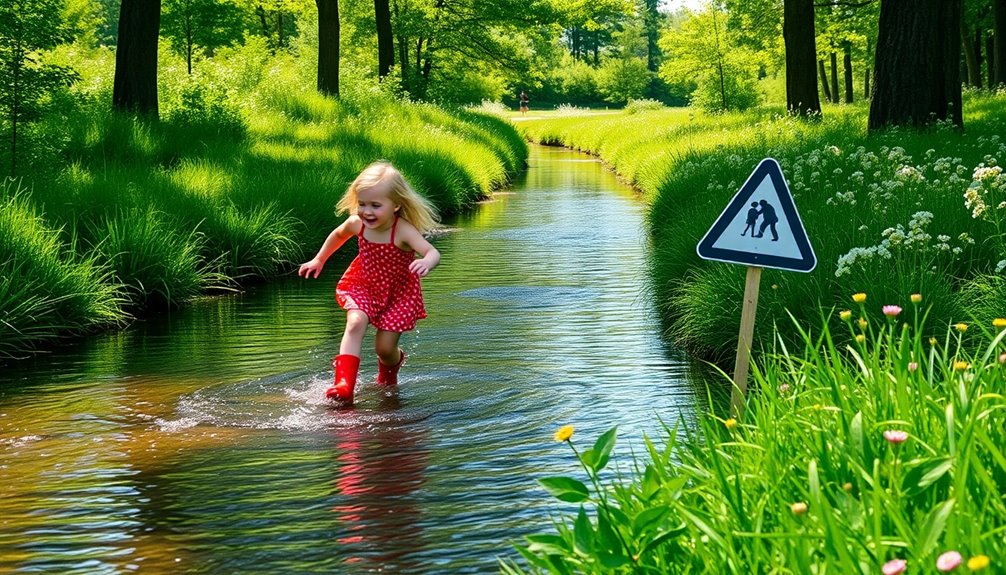
When you have a creek on your property, it's vital to recognize the safety risks it poses for children. Drowning can happen quickly, especially for little ones under 3 years old who might wander off unsupervised.
To keep your kids safe, consider these measures:
- Install secure fencing with a locking gate to restrict access.
- Establish strict rules about playing near the water, emphasizing a zero-tolerance policy for disobedience.
- Teach swimming skills early, but remember that survival classes aren't foolproof.
Regular supervision is important as children grow older and may take more risks near the creek.
Flooding and Water Damage Concerns
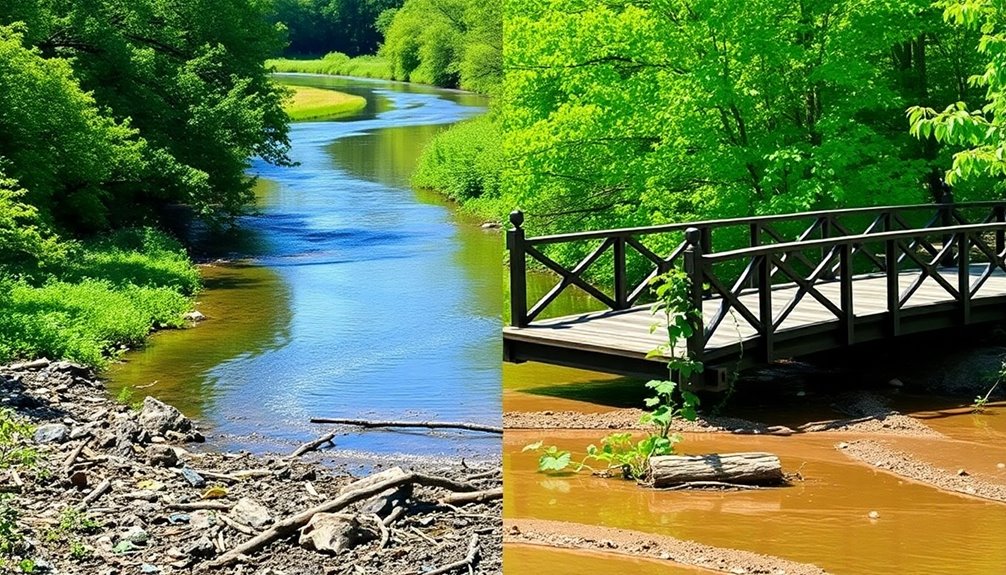
Although having a creek can enhance your property's charm, it also brings significant concerns about flooding and water damage. Properties near creeks often face flood risks, even in areas with moderate to low flood risk. You'll likely need flood insurance, averaging around $800 annually, especially if you're in a designated flood zone. The Federal Emergency Management Agency (FEMA) identifies such zones based on flooding likelihood. Before purchasing, consider a professional inspection to assess flood risks and previous water damage, as undisclosed issues can lead to costly repairs.
| Flood Zone | Flood Risk |
|---|---|
| 100-Year Flood Plain | High risk (once a century) |
| Moderate Flood Zone | Moderate risk |
| Low Flood Risk Area | Minimal risk |
| Adjacent to Creek | Increased risk |
| Insured Properties | Financial protection |
Wildlife Interactions and Management
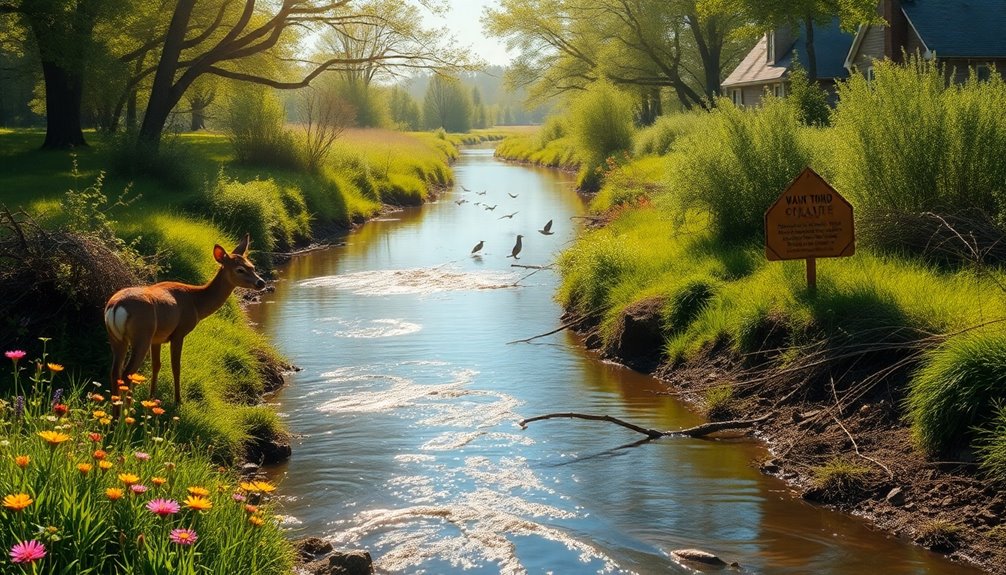
Living near a creek offers a unique opportunity to connect with nature, but it also brings the likelihood of increased wildlife interactions.
You'll likely encounter various animals that can enhance your experience, yet they may pose challenges. Here are three common wildlife interactions you might face:
- Frogs croaking loudly at night, disrupting your peace.
- Geese waddling through your yard, leaving behind messes.
- Snakes seeking shelter in your garden, causing concern.
To manage these interactions, consider implementing wildlife management strategies.
Using sulfur powder can deter snakes, while wildlife-proofing your home helps prevent invasions. Additionally, maintaining a clean environment around your property can reduce the likelihood of attracting unwanted wildlife.
Staying informed about local regulations is essential for protecting native species and ensuring your landscaping practices comply with necessary restrictions.
Environmental Regulations and Restrictions
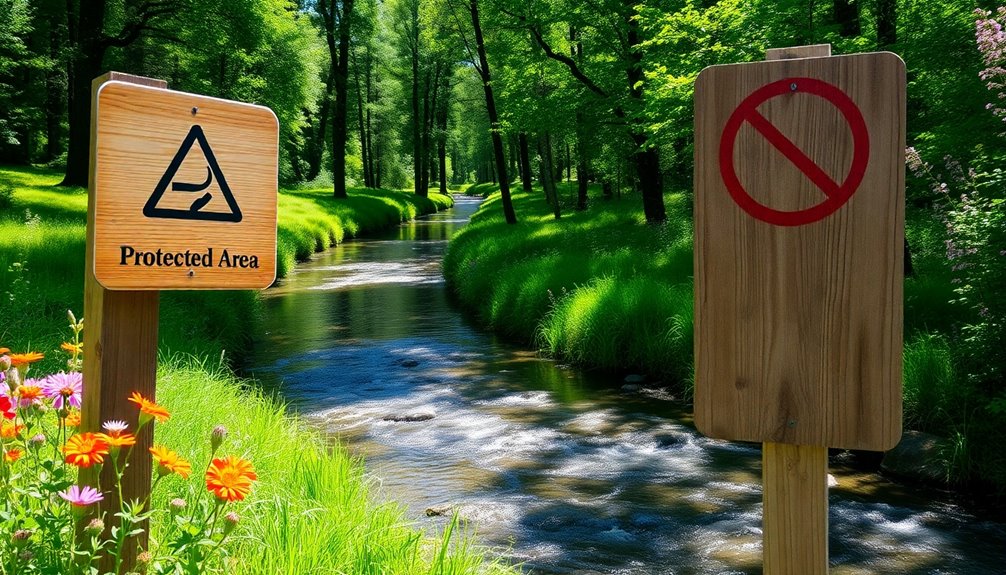
When you have a creek on your property, you'll likely face specific permitting requirements before making any modifications.
These regulations can impact how you use your land, from landscaping choices to fencing options.
It's essential to understand these rules to avoid fines and guarantee compliance.
Permitting Requirements for Modifications
Before making any modifications near your creek, it's crucial to understand that you often need to obtain permits due to various environmental regulations. Failing to comply with permitting requirements can lead to costly fines and the need for restoration efforts.
Here are some key considerations:
- Local Codes: You might face restrictions on tree cutting and landscaping within designated distances from the creek to protect wildlife habitats.
- Watershed Plans: Verify your modifications align with watershed management plans to maintain ecological balance.
- Submission of Plans: Local authorities often require you to submit detailed plans for any construction or landscaping changes for review.
Additionally, understanding the concept of environmental regulations is essential, as it can significantly inform your modification decisions and compliance obligations.
Being aware of these factors will help you navigate the permitting process smoothly while safeguarding your environment.
Impact on Property Use
Having a creek on your property can significantly impact how you use and maintain your land, especially due to environmental regulations that may limit your options.
Properties near creeks often face restrictions on modifications and landscaping to protect natural habitats and water quality. You'll likely need permits for any construction, tree removal, or land alteration within specific distances from the creek, complicating your property use.
Local codes might require native landscaping in creekside areas, narrowing your choices for yard modifications. Additionally, if your land falls under wetland designations, you could face even more stringent restrictions.
Violating these regulations can lead to hefty fines and required mitigation efforts, so it's crucial to familiarize yourself with local laws.
Financial Implications and Insurance
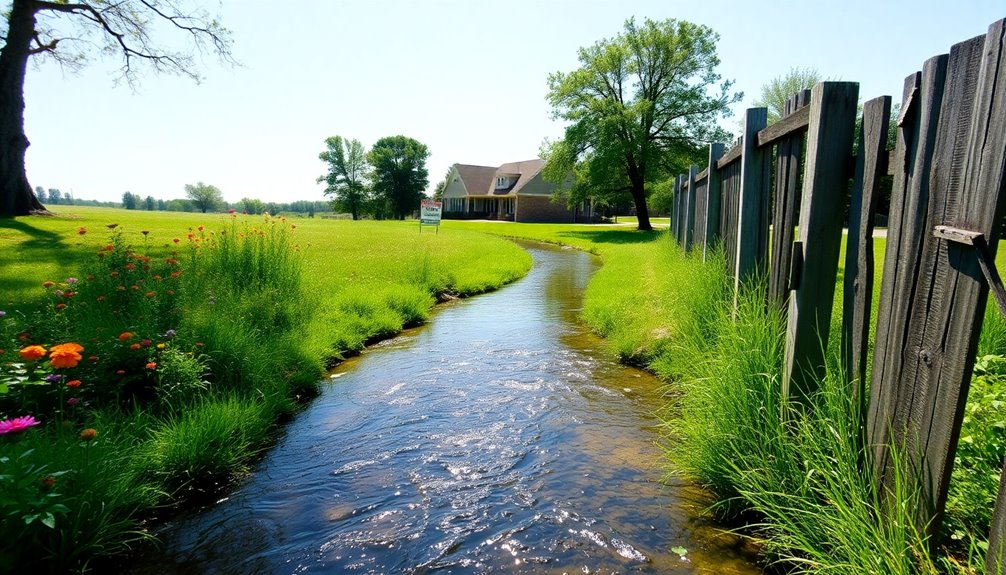
Owning a property with a creek can markedly impact your financial situation, especially concerning insurance. You might need to purchase flood insurance, which could cost about $800 annually, depending on your property's flood risk.
Here are three financial considerations to keep in mind:
- Increased Insurance Premiums: Properties near water bodies often face higher premiums due to the elevated risk of flooding.
- Decreased Market Value: If your property lies in a designated flood plain, it may sell for less, complicating future sales.
- Financial Liabilities: You could be held responsible for damages caused by flooding, leading to unexpected expenses.
A professional floodplain assessment can clarify your specific risks, potentially influencing your insurance costs and property value.
Community Perspectives and Experiences

Living near a creek can spark mixed feelings among community members, balancing the allure of natural beauty with safety concerns, especially for families with young children. Many reminisce about the joy of playing near a creek behind the house during their own childhoods. While some parents feel comfortable with the creek's proximity, they emphasize the importance of safety measures like fencing and supervision to create a safe place for their kids. Additionally, parents often recognize the value of self-regulation in helping children navigate their emotions when interacting with nature.
| Pros | Cons |
|---|---|
| Enhances relaxation | Safety concerns for children |
| Encourages community engagement | Potential flooding risks |
| Provides a beautiful view | Maintenance challenges |
| Nostalgic connections | Wildlife encounters |
| Ideal for outdoor activities | Mosquito and pest issues |
Maintenance and Landscaping Challenges
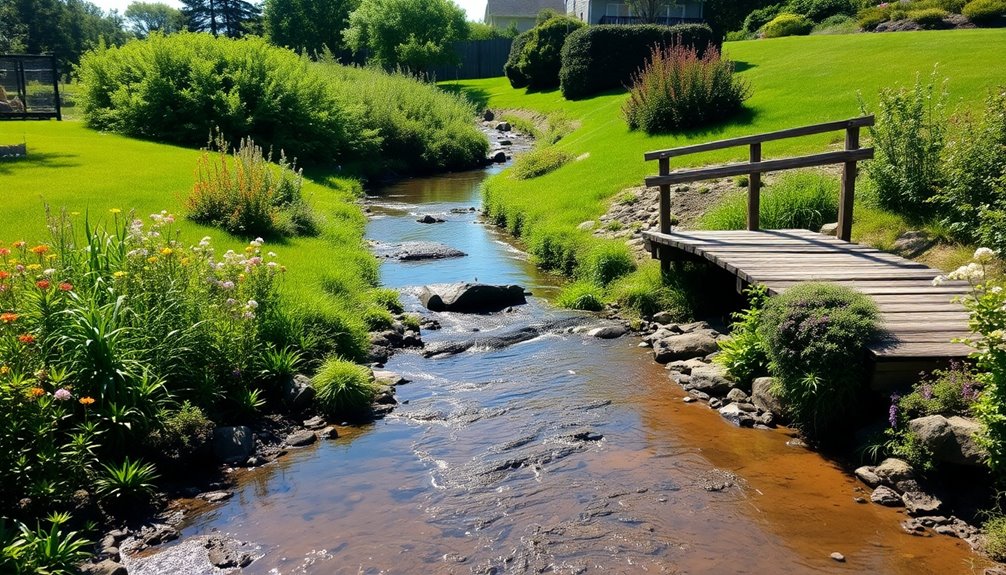
Maintaining a creek on your property means you'll need to tackle erosion control measures to protect your land from costly damage.
You might also face restrictions on the types of plants you can use, as certain vegetation management requirements could limit your landscaping options.
Staying on top of these challenges can be labor-intensive, but it's essential for preserving the creek's health and your property's value.
Erosion Control Measures
While having a creek on your property can enhance its beauty, it also brings maintenance and landscaping challenges related to erosion control. To effectively manage erosion and maintain the creek's integrity, consider these key measures:
- Plant native vegetation along the creek banks to stabilize soil and reduce erosion risk.
- Implement bioengineering techniques like coir logs or live staking to enhance bank resilience and create wildlife habitats.
- Use riprap or boulders in flood-prone areas for structural support during high water events.
Regular maintenance, such as monitoring plant health and removing debris, is essential to guarantee low risk of erosion. Additionally, incorporating power reclining sofas in outdoor relaxation areas can provide comfortable seating while enjoying the natural beauty of your creek.
Vegetation Management Requirements
Having a creek on your property not only adds beauty but also brings specific vegetation management requirements that can complicate maintenance and landscaping efforts.
You might face restrictions on tree cutting and landscaping due to local environmental regulations designed to protect natural habitats and prevent erosion. Maintaining native vegetation along the creek banks is often necessary to comply with habitat preservation laws, limiting your landscaping options.
Ignoring vegetation management guidelines can lead to costly fines or mandated restoration efforts. Regular maintenance is essential to prevent invasive species and guarantee the riparian ecosystem's health, which can be labor-intensive. Additionally, understanding the importance of biodiversity can enhance your efforts in maintaining a healthy creek environment.
Consulting local environmental agencies or landscaping experts can help you navigate these complexities and stay compliant with regulations.
Long-Term Property Value Considerations

When you evaluate the long-term property value of a home with a creek nearby, it's essential to weigh both the benefits and potential drawbacks.
While the beauty and recreational opportunities can enhance your property's appeal, there are risks to take into account:
- Higher Demand: Homes near creeks often attract buyers seeking outdoor spaces and scenic views.
- Appreciation Rates: Properties in desirable neighborhoods with water features typically appreciate faster.
- Flood Concerns: Local zoning regulations may classify your property as flood-prone, impacting property taxes and resale value.
Additionally, considering environmental impact will help gauge the long-term sustainability of living near a creek.
Keep in mind that while a creek can elevate your property's charm, it might also lead to restrictions or depreciation, especially in a year of significant flooding.
Balancing these factors will help you make an informed decision.
Frequently Asked Questions
What Are the Problems With Living Near a Creek?
Living near a creek can pose several problems. You might face unexpected flooding risks, which can lead to costly insurance.
Wildlife, like snakes and insects, might become uninvited guests, increasing health concerns.
Local regulations often restrict modifications to your property, complicating your landscaping plans.
If you have children, unsupervised access to the creek raises safety issues, and you could be liable for accidents that happen on your property, including those involving trespassers.
Is It Good to Have a Creek on Your Property?
Did you know that homes with water features can sell for up to 20% more?
Having a creek on your property can definitely enhance its charm and recreational opportunities. You can enjoy peaceful moments by the water, explore nature, and even fish right outside your door.
However, it's important to take into account potential challenges, like flooding risks and wildlife management.
What Are the Benefits of Having a Creek?
Having a creek on your property brings numerous benefits.
You'll enjoy stunning views and a calming ambiance created by the soothing sounds of flowing water. It attracts diverse wildlife, enriching your outdoor experience.
Plus, you'll have opportunities for recreational activities like fishing and kayaking, promoting an active lifestyle.
This natural feature can also boost your property's value, making it a desirable asset if you ever decide to sell.
What to Do With a Creek on Your Property?
Picture the gentle babbling of water flowing over smooth stones, sunlight dancing on its surface. You can transform your creek into a vibrant oasis.
Start by clearing debris and planting native plants to boost water quality. Create safe play areas for kids, keeping them away from the water's edge.
Explore recreational activities like fishing or kayaking, while ensuring you follow local regulations.
Finally, consider erosion control measures to protect your beautiful natural space.
Conclusion
Having a creek on your property can transform your space into a serene oasis, teeming with life and endless possibilities. But as you stroll along the water's edge, you can't shake the nagging thought—what if it floods? The beauty and recreation it offers come hand in hand with hidden risks and maintenance demands. As you weigh the pros and cons, imagine the balance between tranquil moments and the unpredictable nature of water. What choice will you make?
